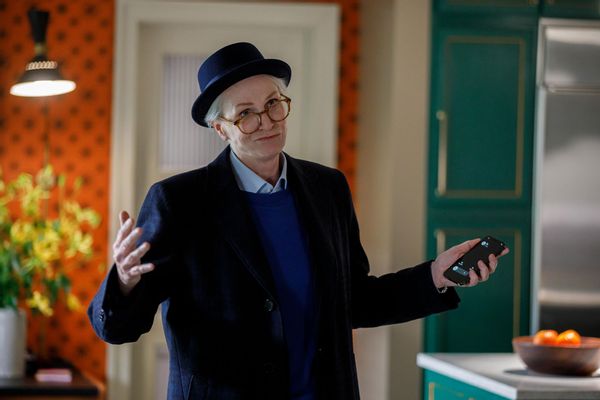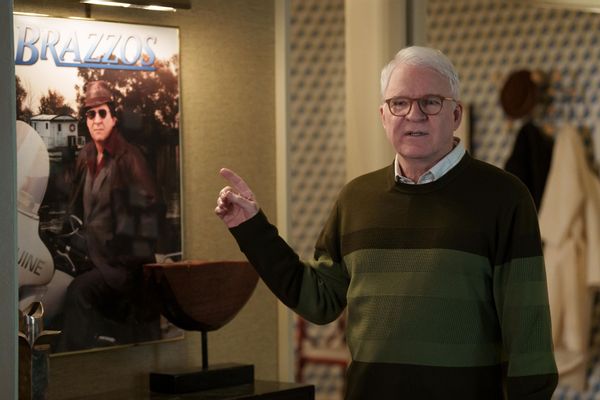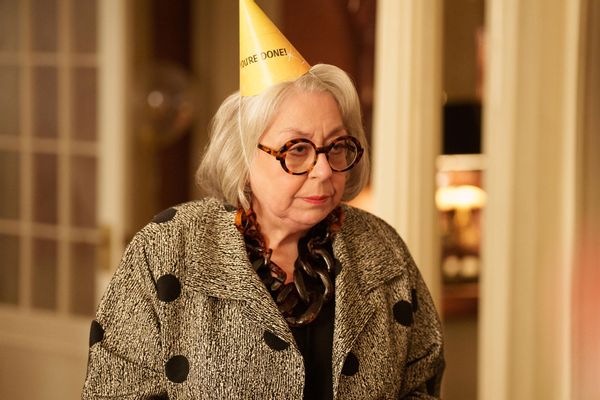
"Only Murders in the Building" is a puzzle box of references; secret passageways, asides from Oliver (Martin Short) about his past that may or may not be relevant (or true). One of its great surprises was the reveal of the stand-in for TV actor Charles (Steve Martin) who played Brazzos, a jaded detective, on a long-running cop show of the same name.
As Brazzos, a kind of cross between David Caruso's John Kelly and Columbo, Charles wore a brown leather jacket and sunglasses inside like Corey Hart, an ever-present toothpick dangling from his lips as he uttered his signature line: "This sends the investigation into a whole new direction."
And as his stand-in on the show — and sometimes, increasingly, in his life — we have Jane Lynch.
The surprise of Lynch as Sazz Pataki is a gift that keeps giving. Not only do Lynch and Martin resemble each other in breathtaking ways, so much so that Oliver and Mabel initially think Sazz is Charles with their identical pork pie hats and oversized suit jackets, Sazz has Oliver's mannerisms down. She's played him so much she's become him in her off hours — the way they sit, the way they move their arms or read the paper. The way they react.
And she hasn't just played him onscreen. Charles has social anxiety while Sazz is a confident, queer woman with clear, resonant sex appeal; she stole Charles' girlfriend once. But, no hard feelings. Like an alter ego, Sazz is there to step in for Charles during the difficult times, being it TV sex scenes (Charles' hip movements weren't "natural") or in the episode "Performance Review": rough life stuff. Get you a stand-in who will visit prison for you.
Martin and Lynch are both 6 feet; both have short white hair. But how did the character of Sazz come about, and who landed on the genius idea for Lynch to play her? Salon talked to "Only Murders" co-creator John Hoffman about Lynch, Sazz, the heart of true crime and more happenings in our favorite, homicidal apartment building: the Arconia.
This interview has been lightly edited for clarity and condensed.
What was your approach to this second season? Especially coming after a first one that was so successful and is so loved.
I think the approach is always narrative first. You have to ground yourself in the characters and the story and feeling: what's the brightest, funniest way to tell a story where three characters have really stepped into it at the end of season one? So that was the first thing driving us. Of course, now that Season 1 is out, the world knows the show. There have been responses to it, and the embrace was so lovely . . . I was really thrilled that our mystery built a lot of interest as well. That was a real pursuit of ours, knowing that we needed to do that, but the thrill of watching these message boards light up with theories and mystery abounding, it was just fantastic. And so there was the onus on us, certainly to: "OK, now have to craft a second season mystery."
When doing that, there was the next level, meta part of our show that is: here we have our three characters trying to set up to do a second season of their own podcast. And so there were moments — probably maybe a little too many here and there; they were so fun to play with as writers to call up the insecurities of trying to craft an equal to or better than second season of anything when it's been embraced like that. That was really fun.
"It was one of the greatest moments you could ever have in a writers' room, I will tell you honestly — and I wasn't even in the room."
I encourage everyone to hang tight because there are many things coming at our heroes in Season 2, and it feels a touch disorienting. That's very intentional because of the situation they're in. But I'm very excited for people to see the full season because I guarantee a big-time banger coming around at the end.

Oh my God. It was one of the greatest moments you could ever have in a writers' room, I will tell you honestly — and I wasn't even in the room. That was why it was probably so good, but I was out for, I think it was a phone call, and then I came back in. And we've been on Zoom both seasons of this show; we wrote the whole thing on Zoom, which is not easy. We tried very hard to use programs that would allow us to have a digital whiteboard, which is the most essential thing in a writers' room, especially when crafting a mystery like this, but we couldn't seem to manage that. I feel so proud of this writers' room in so many ways, but that was one of the things: holding all of it in our heads as we were discussing and crafting both seasons.
"We bypassed agents. We bypassed everybody. Jane said, 'I'm in.'"
When I came back from this phone call, I saw each little square of this writers' room on Zoom, they looked like they'd eaten the cat that ate the canary. It was unbelievable. [They said], "We have something to pitch you." And I said, "OK, what's going on?" And they said, "So, Charles-Haden Savage from his days in 'Brazzos' has a history with his stunt double." They went into that history and then they just landed right off the pitch. But the big pitch is that this stunt double has to be played by Jane Lynch.

"At the heart of it are those three lonely, isolated people who need to help each other. And through this weird obsession with this mystery that lands in their lap, find a life raft in each other."
The next step was how do we get her to commit at this early stage to this part, and luckily one of our co-executive producer writers, Kristin Newman, had been friendly with Jane Lynch. I think there was an apartment situation where Jane was staying in Kristin's apartment at some point. Kristin literally texted and said, "Hey, there's a part here, blah, blah, blah, Steve Martin, Martin Short, Selena Gomez, Hulu. And here's the part." We bypassed agents. We bypassed everybody. Jane said, "I'm in. When is it? I'm in."
We had to go through negotiations. We had to check her schedule, our schedule, all of that, but one of the great miracles of Season 1 for me was that not only did we get Jane Lynch to play this part as pitched, she just went above and beyond, fulfilling our dreams on set with her and Steve. [She] found things, the gesturing that marries the two of them — all of it was just heaven.
It's really remarkable to see on screen.

"We were more necessary than we might have been otherwise had we not been spending the last two, three years isolated and lonely — and wondering if the person in the hall might kill us."
It was a big leap. The show takes these big leaps and we're like, "OK, they either buy all into our leaps or . . ." And they do comedically. We do it with some poignant moments too. I'm not shy about the storytelling in many ways. I've just been so delighted that the audience response to all those leaps has been one collective "we're all diving in together."
It reminds me of a part I really loved in the first season where Martin Short's character is talking about that theatre performance with the fall, and there's the montage where all the characters have a fall in a sense. And the show is always falling, I guess, but the audience is always falling with them.
That's so sweet of you to say that. Yes, it's very much the central core of the show that at the heart of it are those three lonely, isolated people who need to help each other. And through this weird obsession with this mystery that lands in their lap, find a life raft in each other. They're constantly being pulled up to the surface by each other by this thing they're following. Meeting each other is what they've come to learn, to help get them out of their own ways and their own path.
"It is very important to point out that true crime is still crime and true crime still has great truth in it. That truth is multidimensional always."
Unintentionally, it feels like a very prescient topic to swing into in these times that we're in, and I don't know, the timeliness of when we dropped, it felt like we were more necessary than we might have been otherwise had we not been spending the last two, three years isolated and lonely — and wondering if the person in the hall might kill us.

And unexpected places to find that connection. That's the real connective tissue to the whole show, and that's the hope of it, I think. You always have to keep that front of center between the three of them in the building and in the spirit of the show.
This season we get that deepening of some minor characters and we get more history from everyone, including Bunny, whose backstory actually made me cry. I hated Bunny in the first season, and then by the second season, I'm crying over her loss. So, what were the creative decisions that went into deciding to have those backstories?
It feels necessary to me. Our whole show is built on this understanding of using and playing with and poking fun of the format of the podcast, and the true crime podcast particularly . . . But beyond that, I felt that it is very important to point out that true crime is still crime and true crime still has great truth in it. That truth is multidimensional always. And for victims, for a person committing this crime, there's no forgiveness, but there is humanity: an understanding of what drives people and what motivates people to be the way they are, and to walk the world on a daily basis the way they do.
Want a daily wrap-up of all the news and commentary Salon has to offer? Subscribe to our morning newsletter, Crash Course.
I think remembering and reminding about that, about all the dimensions to people who you might presume certain things about, finding the humanity that makes you realize, "Holy crap, this is someone I might have enjoyed spending time with," when you on the surface might not have felt that way. To me, it's essential to the storytelling we do.
"Only Murders of the Building" releases new episodes Tuesdays on Hulu.







